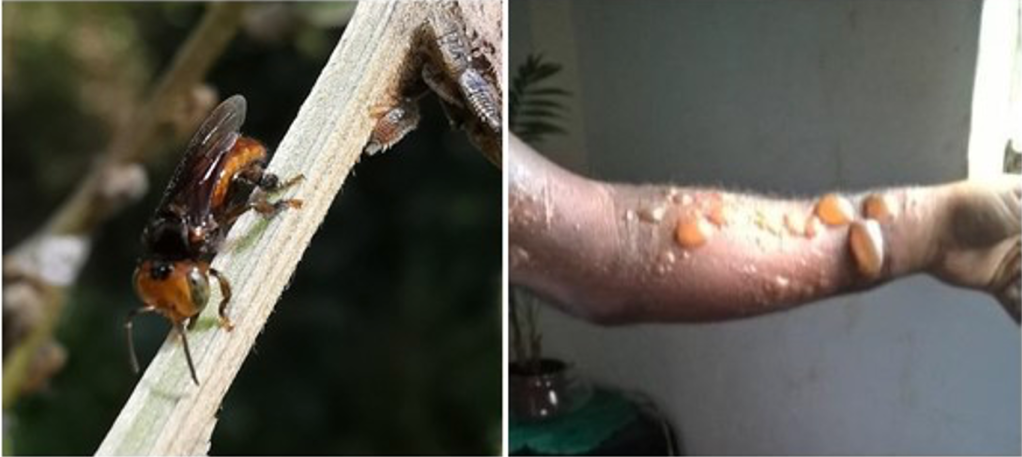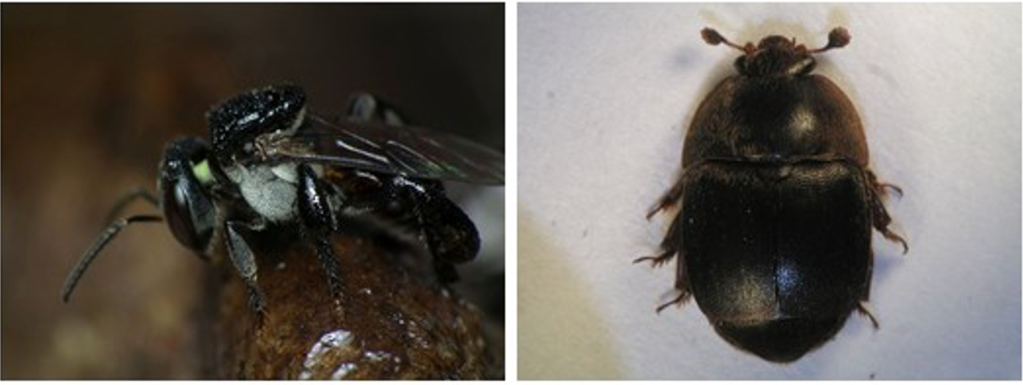Thanks to a range of excellent presenters, our Third Annual Pollinator Conference seemed to hit the mark in mid-June. The subject was monitoring, and our speakers were on top form. From a range of talks we got a real sense of the ‘why?’ and ‘how?’ behind monitoring our insect populations.
The aim of the conference was to demystify recording insect numbers and trends, whilst emphasising the value of monitoring in understanding and sharing information around changes in biodiversity. Our speakers revealed how they gather information and what they do with it.

Anthony McCluskey of Butterfly Conservation opened the day by talking about insect declines and the fact that it was repeat monitoring that allowed him to make such statements with confidence. Anthony gave a good example of the value of monitoring in noting general trends and picking up on individual anomalies. In the latter category he cited the example of the orange-tip butterfly, which surveys reveal to have doubled in the past 10 years.
“Monitoring allows us to ‘take nature’s pulse’,” noted Anthony. It throws a spotlight on climate change impacts, and only with monitoring can his organisation know which species they should be concerned about.

“What makes a good monitoring record?” was a question that Anthony was keen to answer. He explained that a useful record requires a date, an approximate location, and a species identification. He gave us an insight into the iRecord butterflies app, the UK Butterfly Monitoring Scheme, and the forthcoming Garden Butterfly Survey.
Anthony was followed by Richard Comont, Science Manager at the Bumblebee Conservation Trust and well-versed in all things bumblebees. His talk on BeeWalks was an insight into monitoring across the board. His starting point was the assertion that any conservation organisation needs accurate up to date information to know where ‘their’ species are and how they are faring. He used the Great Yellow Bumblebee as an example for where monitoring paints a valuable picture.

He then gave us an insight into BeeWalk, which is one of a suite of biological recording projects in the UK. Richard outlined how volunteers count and identify bees as they go along a set route. Richard acknowledged that some bumblebees are hard to identify, but noted that BeeWalk has an impressive record of training people in identification skills. Beewalk has fired the public imagination across the UK, with over 250,000 records submitted.
Richard gave us a lovely Scottish example of public participation in the Cairngorms, where the face-to-face Skills for Bees project is drawing increasing input from a small army of volunteers. And he concluded that good data is a cornerstone of making progress in the quest to help bumblebees thrive.

Claire Carvell, ecologist at the UK Centre for Ecology & Hydrology, gave us an insight into the increasingly popular PoMS FIT Count work. Claire explained how UK PoMS is the world’s first monitoring scheme generating systematic data on the abundance of bees, hoverflies and other flower-visiting insects at a national scale. She pointed out that UK PoMS provides much-needed evidence to the UK’s four national pollinator strategies.
She described how the Flower-Insect Timed (FIT) Count survey works, pointing out that the aim is to collect data on abundance of flower visitors and plant-pollinator interactions across a variety of habitats. Participants are advised to count all insects that land on flowers of a target flower species within a 50×50cm patch during a 10-minute period, and identify insects from broad groups.

Claire’s attractive and informative diagrams and infographics showed us how FIT Counts are revealing the importance of different insect groups to different flower types , as she explained how this data is used and communicated.

After our break, Claire’s colleague Martin Harvey, who was representing UKCEH Biological Records Centre, PoMS, and the Dipterists Forum, lifted the lid on the world of recording and monitoring flies. Given that hoverflies alone visit at least 72% of our global food crops, it was clear that Martin’s subject was important. His talk was good on details, both large and small.

For the non-dipterists in the audience, Martin included a useful ‘Fly Features’ introduction, before giving us an insight into the resources available through the Dipterists Forum. We were also taken through the crucial ‘data crunching’ that follows monitoring exercises. It was a revealing journey noting challenges and methods, and ended with Martin having made his point on just how important flies are as pollinators.

‘Trends and the importance of monitoring’ was the title for Simon Foster’s talk. NatureScot’s Trends and Indicators Analysist commenced with the bald fact that we face the twin crises of climate and biodiversity issues, referred to the IPBES drivers for biodiversity loss, and emphasised that we need monitoring if we are to tackle these threats. “Indicators”, he explained, “let us monitor changes in Scotland’s species, habitats and landscapes, and reflect wider changes in the natural environment.”
Making best use of robust indicators was very much part of Simon’s presentation and he explained the value of a set of ‘Smart’ objectives, measuring specific, measurable, achievable, relevant and time bound elements. He then took us through some of the trends that have caught his eye, one of which was that warmer summers may cause short-term butterfly increases in Scotland but that this increase probably won’t continue in the face of increased frequency of drought and fires resulting from climate change. Simon rounded up by acknowledging the role of citizen scientists.
We headed over to the Netherlands for our sixth presentation as John Smit, of the European Invertebrate Survey, introduced a talk about the Dutch Bumblebee Monitoring Program. John acknowledged that there was a lot of data in the Netherlands, such as the citizen science portal – waarneming.nl, but he conceded it was ‘just not the right data’.
He explained that their goal was long-term data, gathered to a standardized protocol and gathered nationwide. The Netherlands, he informed us, has 24,000 insect species, over 1,000 of which are pollinators, with 370 of them comprising bees. Clearly that posed a challenge, and thus a decision was made to focus on the 22 species of bumblebee. The advantage of this approach is that bumblebees are relatively easy to find, common in many habitats, and ‘fluffy and cute’, which helps in getting wide public involvement. On the reverse side of the coin are challenges such as difficulties around identification, not being feasible to handle, and the fact that even willing volunteers usually need training.

As with other schemes in Europe, the Netherlands project used existing Butterfly Monitoring Programmes as a springboard, a particularly useful tactic as bumblebees and butterflies were roughly found in the same habitats at the same time of year. Good communication is key to engaging people, and a sequence of excellent bumblebee drawings were among the highlights of John’s session.
A five-year pilot has now ended and John stressed the value of sharing results. Tactics employed included publishing articles online, harnessing the reach of social media and networking, regular volunteer meetings, frequent lectures and newsletters. The good news is that the pilot has resulted in the monitoring work being absorbed into the official Dutch Ecological Monitoring network.

We wrapped up our event with a presentation from Petra Dieker from the Thuenen Institute of Biodiversity. Petra began by explaining that many of the 590 wild bee species recorded in Germany are found in agricultural landscapes, and that in Germany around 50% of the land mass is used for agriculture. Hence a focus on monitoring in an agricultural setting made perfect sense.
Work began with a four-year pilot scheme to create a nationwide data base describing changes to wild bee populations and their habitats. From this it is anticipated that identifying potential biodiversity-enhancing measures will follow. Such an ambitious project required a substantial team of trained volunteers, in particular farmers.

The method was interesting and adopted a non-lethal approach in sampling. Bee houses, or ‘nesting aids’, were installed at sites across German with a view to attracting bees that nest in cavities.. The 25-storey nesting aid provided a valuable source of data: nesting material, eggs, larvae and, of course, adult species all being observed by volunteers.

Petra’s answer to the question “Could trained volunteers identify nesting aids inhabitants themselves?” was a resounding “Yes”, with over 90 percent of their recording being correctly identified.
Petra also discussed a series of bumblebee identification courses which have been benefitting from the creation of small pollinator gardens. These are popular with pollinators and the feeding insects are more or less at eye-level and thus easy to observe.

The conference was over in a flash, always a sign of things going well, and the feeling was that this was the best we have hosted to date. If it was, then that’s thanks to a stellar line up of presenters, each and every one of whom had a captivating story to tell, and told it brilliantly.
Useful links:
You can follow the work of our presenters and their organisations across various social media and digital channels.
Anthony McCluskey and Butterfly Conservation = www.butterfly-conservation.org/recording and email by amccluskey@butterfly-conservation.org
Richard Comont and Bumblebee Conservation Trust work = www.beewalk.org.uk, follow Richard on twitter @RichardComont. In addition details of the Skills for Bees projects can be found at https://www.bumblebeeconservation.org/skills-for-bees-scotland/
Claire Carvell and the UK PoMS Team = poms@ceh.ac.uk and @PoMScheme, @Claire_Carvell. Keep in touch with PoMS updated @ https://ukpoms.org.uk/subscribe
Martin Harvey = Dipterists Forum online and follow Martin on twitter @ kitenet and the Biological Recording Centre @___BRC___. also follow @PoMScheme on twitter too.
Also https://royalsocietypublishing.org/doi/10.1098/rspb.2020.0508 and https://esajournals.onlinelibrary.wiley.com/doi/10.1002/eap.2859 and
Simon Foster = follow the Trends and Indicators work at Nature Scot via https://www.nature.scot/information-hub/indicators-trends/scotlands-indicators
https://sustainabledevelopment.un.org
https://nationalperformance.gov.scot/measuring-progress/national-indicator-performance
John Smit and EIS Nederland = https://www.eis-nederland.nl/veldtabellen
Petra Dieker = find out more on the website @ https://wildbienen.thuenen.de and follow Petra on twitter at @PetraDieker































